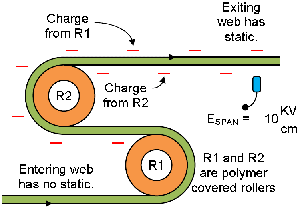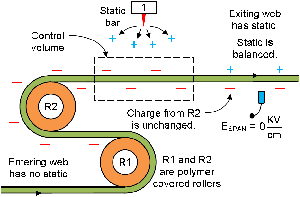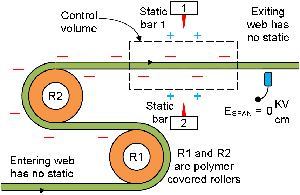Static Beat | S-Wrap Rollers
- Published: July 13, 2012, By Kelly Robinson
Web cleaners often use S-wrapped tacky rollers to clean both sides of the web, and some machines use S-wrapped drive rollers to improve traction. These S-wrapped rollers present a unique challenge because static charge is put on both sides of the web.
Static charge on the web from roller R1 in Figure 1 is on the top surface of the exiting web, and static charge on the bottom of the web is from roller R2. The total amount of static can be measured using an electrostatic fieldmeter. The fieldmeter reading ESPAN on the exiting web span is -10 KV/cm, which is quite high. Sparks are likely when the fieldmeter reading exceeding ±8 KV/cm.

Static control systems are designed to produce electrically neutral products. Ideally, the material exits each production step with no static charge. Where can we install static bars so that the exiting web is static free? S-wrapped rollers usually are too close together to put a static bar between the rollers.
Let’s try putting a single static bar on the web span exiting the S-wrapped rollers. To analyze the performance of static bar 1 in Figure 2, draw a control volume around the web in front of the static bar. The control volume contains four negative charges. Static bar 1 responds to the total charge inside the control volume by generating four positive charges. These positive charges move through the air and deposit on the web surface facing the static bar.

Look what happens. The static charge from roller R2 on the bottom surface is unchanged. The ions from the static bar cannot move through the insulating web. The static bar has added just enough positive charge to the top surface to balance the charge on the bottom surface. The result is that the exiting web has static.
The electric fieldmeter reading on the exiting span is zero. To understand the fieldmeter reading, draw a control volume around the web in front of the fieldmeter. The meter responds to total charge inside the control volume, which is zero. So, the zero fieldmeter reading confirms that the static bar has balanced the charge effectively. Note that the charge is not necessarily zero.
This balanced charge will not produce electrostatic discharges (sparks). Dust and other contaminates are not attracted to a web with balanced static charge. So, the static bar has certainly helped mitigate some static problems. However, this balanced static will cause high static on the winding roll, and it will cause static problems when the roll is unwound in the next operation.
Now, let’s try using two static bars on the exiting web span. We’ll mount the bars in Figure 3 so that they face each other. To analyze the installation, draw a control volume around the web between the static bars. The control volume contains four negative charges. Since the two static bars are located symmetrically, they respond equally to the total charge inside the control volume. Each static bar generates two positive charges that move through the air and deposit on the web. Now, the web exits with no static charge. The electrostatic fieldmeter reading ESPAN confirms that the charge is balanced. In this case, the balanced charge is zero charge on both surfaces. play slots online for free and without registration in casino queenofluck number of bonuses becomes more profitable for players to play

The two static bars must be equally distant from the web. Follow the manufacturer’s directions for static bar installation. Typically, each static bar should be 1.5–2 in. from the web. Static bars that are too close can deposit large amounts of static on the web.
Static control systems are designed to produce static free product. When an equal amount of static charge is on both surfaces of a web, two static bars facing each other will neutralize the symmetric charge.
I invite you to ask questions about this column and to suggest future topics. Static control expert Dr. Kelly Robinson, president of electrostatic Answers, has 27+ years of experience in prolem-solving and consulting. Contact him at 585-425-8158; Kelly.Robinson@ElectrostaticAnswers.com; www.electrostaticanswers.com.










